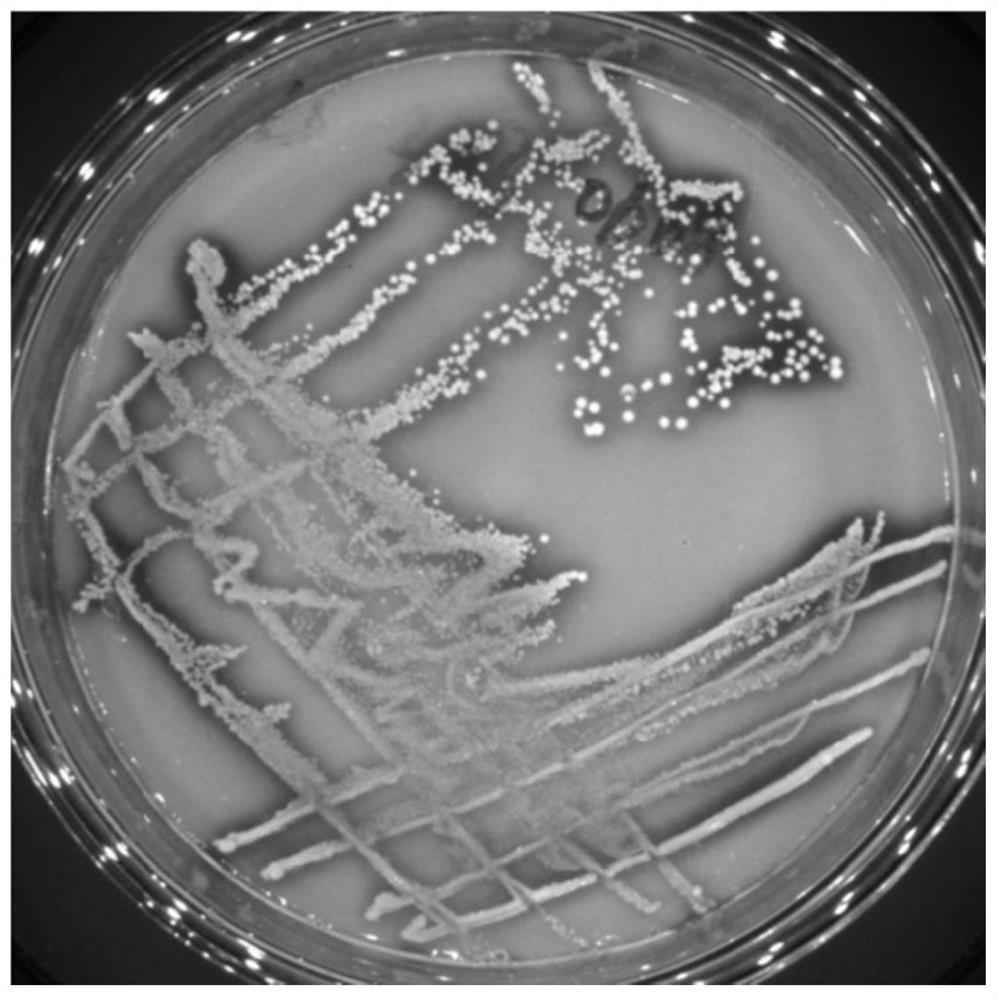Lactobacillus fermentum 9-4 and its application
A technology of fermented lactobacillus and fermented food is applied in the development of functional lactic acid bacteria and the production and development of its products, and in the field of microorganisms. Human body utilization, beneficial to the preparation of fermented products, and the effect of good tolerance
- Summary
- Abstract
- Description
- Claims
- Application Information
AI Technical Summary
Problems solved by technology
Method used
Image
Examples
Embodiment 1
[0053] Isolation, purification and preliminary screening of lactic acid bacteria strains in raw rice flour
[0054] 1. Isolation and purification of lactic acid bacteria
[0055] Weigh 2.5g of each raw rice flour sample, and dilute it with sterilized normal saline at a rate of 1:9, which is 10 -1 Dilution, take the above diluent and dilute it 10 times with normal saline, which is 10 -2 Sparsity, and so on, for serial dilutions. take 10 -1 、10 -3 、10 -5 、10 -7 Dilution, draw 100 μL respectively and spread on MRS medium, do two repetitions for each dilution, place in a 37°C incubator, cultivate for 48 hours, wait for the colonies to grow, pick the characteristic colonies of lactic acid bacteria with calcium-dissolving circles on the plate ,Such as figure 1 . Pick 3-4 single colonies from different plates and further purify by streaking.
[0056] A total of 35 strains were isolated from ten samples in Nanning City. The purified strains were stored in 15% glycerol and fro...
Embodiment 2
[0078] Molecular biology identification of primary screening lactic acid bacteria
[0079] 1. Genome Extraction
[0080] Inoculate the 8 strains that have passed the preliminary screening in the MRS medium with 1% inoculum amount, and take 3 mL of the bacterial liquid when they are cultured to the logarithmic phase. Perform genomic DNA extraction. After extraction, agarose gel electrophoresis was carried out for verification, and the verification results were as follows: Figure 6 shown.
[0081] 2. PCR amplification
[0082] Quantify the extracted gene DNA sample solution using an ultra-micro-volume full-wavelength spectrophotometer, and dilute it to 1 ng / μL, and use it as a template for PCR amplification. The specific sequences of primers 27F and 1492R are respectively SEQ ID No.2 and SEQ ID No.3 in the sequence listing. Construct a PCR reaction system according to Table 5, and use a PCR instrument for amplification. The amplification program is 94°C for 5 minutes, 94°C...
Embodiment 3
[0092] Screening of nornucleoside strains
[0093] Nucleosides in food are precursors for the formation of purines and are the main source of purines in the body. In order to screen out the strains with the function of reducing nucleoside, the metabolic ability of resting cells to inosine and guanosine was used as an index, and the inosine, guanosine, purine, etc. were detected by Waters e2695 high-performance liquid chromatography to understand each strain Ability to metabolize nucleosides.
[0094] Prepare 2mL HPLC inosine standard sample, guanosine standard sample and inosine-guanosine reaction solution system according to Table 7 below.
[0095] Table 7 HPLC 2mL solution system
[0096]
[0097] The 7 strains screened and identified were inoculated in MRS medium with 1% inoculum. After 16 hours, 10 mL of the bacterial liquid was taken at 4°C and centrifuged at 12,000 r / min for 3 minutes to collect the bacterial cells. The cells were washed with 1 mL of normal saline...
PUM
 Login to View More
Login to View More Abstract
Description
Claims
Application Information
 Login to View More
Login to View More - R&D
- Intellectual Property
- Life Sciences
- Materials
- Tech Scout
- Unparalleled Data Quality
- Higher Quality Content
- 60% Fewer Hallucinations
Browse by: Latest US Patents, China's latest patents, Technical Efficacy Thesaurus, Application Domain, Technology Topic, Popular Technical Reports.
© 2025 PatSnap. All rights reserved.Legal|Privacy policy|Modern Slavery Act Transparency Statement|Sitemap|About US| Contact US: help@patsnap.com



